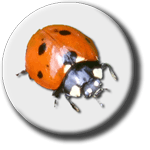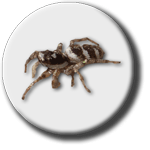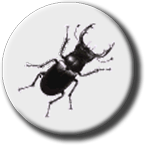A Creepy-Crawly Special!
by Ruth D'Alessandro
I
f you suddenly change from non-organic to organic gardening, one of the first
things you’ll notice is the increase in insects. "More pests!"
I hear the cry, and well, yes, more pests, but also more predators.
This year, more than last, I’ve seen vast numbers of
ladybirds on the allotment. Last winter was a relatively mild one, and overwintering
colonies of ladybirds in houses, sheds and greenhouses were not killed off by
severe frosts, so they emerged refreshed from their winter hibernation, famished
and ready for some juicy aphids.
 At
the beginning of the growing season, my perpetual spinach and runner beans were
covered in blackfly, and I was loathe to use either soapy water or derris, (both
acceptable organic aphicides). I decided to let nature take its course and see
what would happen if I left the blackfly untouched. The first couple of spinach
harvests required thorough washing to get rid of the blackfly clinging to the
leaves, but by the third picking, the leaves were clear of aphids.
At
the beginning of the growing season, my perpetual spinach and runner beans were
covered in blackfly, and I was loathe to use either soapy water or derris, (both
acceptable organic aphicides). I decided to let nature take its course and see
what would happen if I left the blackfly untouched. The first couple of spinach
harvests required thorough washing to get rid of the blackfly clinging to the
leaves, but by the third picking, the leaves were clear of aphids.
Closer observation revealed feisty little six-legged creatures
about 1cm long, shaped like tiny black crocodiles with red spots on their abdomens,
eagerly scoffing the blackfly on the spinach. These are ladybird larvae and
are the terrestrial equivalent of dragonfly larvae - voracious and predatory.
Do look out for these and try to preserve them as they are your natural pest
control. They pupate in black chrysalises shaped like slipper limpet shells
which you’ll find stuck to the underside of leaves or on plant stems.
The adult ladybird which is pale in colour, emerges from the chrysalis on a
warm day and dries its wing cases in the sun. As the cases dry out and harden,
they begin to turn the characteristic adult colour which is generally scarlet,
although other species are yellow or black.
Other predators on aphids are several varieties of tiny wasp.
I noticed their handiwork on some nasturtiums I pulled up recently. In midsummer,
I was lazing on the grass with a long cool 
John Cromptondrink (all in the cause of research for
this column, you realise) when I noticed a tiny black wasp, about 5mm long ‘worrying’
the blackfly on the nasturtiums. The blackfly were obviously perturbed by their
visitor as they were waving their abdomens at it, trying to shake it off, but
it was obvious the wasp was ‘stinging’ selected individuals.
About a month or so later when I pulled up the nasturtiums,
the blackfly were still there, but dead, and in a form reminiscent of an arthropodic
horror movie. They had swelled up to twice their size and instead of being soft-bodied,
they felt as if they were made of dried up resin. Each abdomen had an exit hole
cut in it. I suppose this was indeed a form of arthropodic horror - Welcome
to the Unpleasant World of the Predatory Wasp!
I would need to Ask
The Ranger exactly what species of predatory wasp preys on blackfly, but
I can tell you the full extent of what happened to these unfortunate aphids.
The wasp ‘worrying’ the blackfly was a female, and when she ‘stung’
each aphid, she was in fact pushing her ovipositor (egg laying apparatus) into
it and releasing an egg. Some wasps paralyse their prey before laying their
eggs on it, others merely lay the egg. The wasp larva then hatched and fed on
its host blackfly from inside, grew to maturity, made an exit hole in the abdomen
and emerged as a fully developed adult wasp to mate and begin the cycle all
over again. Good news for you the gardener, ghastly news if you’re a targeted
aphid.
There are many, many species of predatory wasp which prey on
everything from caterpillars to crickets and spiders. Some are tiny and inconspicuous,
such as our aphid wasp, whereas others such as the large ichneumon fly, with
its yellow and black markings and whiplike ovipositor, are quite beautiful.
If you’re interested in this family of wasps, look out
for a wonderful book called ‘The Hunting Wasp’ by John Crompton
in your local second hand bookshop. It went out of print a long time ago, but
if you’re lucky enough to find a copy, treasure it.
One of the signs of a healthy garden is a profusion of spiders,
and this year, we had a whole load of them! Spiders are master predators, and
will eat unwanted insects (and wanted ones too - a meal is a meal.) The three
species most obvious in our garden this summer were the black and white jumping
zebra spiders (Salticus scenicus), 
Zebra spider (salticus senicus)the brown wolf spiders (Pardosa
species) that carry their eggs and then babies around on their backs, and
then the steadily swelling garden orb spiders (Araneus species) which
are responsible for those huge dewdropped autumn webs. All three of these types
of spider are fascinating in different ways.
The zebra spider has to be every arachnologist’s favourite,
with its anthropomorphic cheekiness, seemingly cocking its head at you and watching
with beady eyes. In fact, it has the best eyesight in the spider world, enabling
it to spring onto its prey with remarkable accuracy. Interestingly, the spider
jumps by pumping fluid hydraulically into tissue in its legs, rather like a
mammalian penile erection, except the erection happens suddenly rather than
gradually, hence the spring.
You can have great fun with these spiders. Find one on a sunny
surface and menace it gently with a pencil point. Although the pencil (and you)
are many times the spider’s size, it will firstly respond by raising its
front legs in defiance, and if that doesn’t deter you, it will run at
the pencil and try to bite it. Retire gracefully at this point, otherwise the
spider will seize the pencil and beat the hell out of you.
One of the signs of a healthy garden
is a profusion of spiders.The wolf spider is a picture of maternal tenderness.
The female carries a ball of eggs around with her until they hatch, and then
the baby spiders climb up and cling to their mother’s back and are carried
round by her until they go their separate ways. Wolf spiders, like the zebra
spider, do not spin webs, rather, they pounce on their prey. You’re most
likely to see them sitting motionless on warm stones as they love to bask in
the sun.
The garden orb spiders are certainly among the most dramatic
of our native spiders as they grow quite big by the autumn. They have fat brown
bodies with distinguishing white markings on them. You’ll see the young
spiders at the beginning of summer, and as the season progresses, you’ll
most certainly get caught up in their webs as they spin them across gaps of
a metre or more. The plentiful summer insects mean that they grow to large size
(up to 2 cm) and spin strong webs. I observed a particular favourite orb spider
that took up residence on my washing-line last year, and noticed that it caught
a common wasp in its web, wrapped it in silk and feasted on it for a couple
of days. The spider was around for a couple of months, catching large insects,
until one day it was there no longer. Perhaps it fell victim to a blackbird,
perhaps it wandered off, perhaps it will turn up in my underwear drawer. I was
quite sad to see it go. But that’s nature for you.
Of course, there are hundreds more species of spider that you’ll
find in your gardens, and different ones depending on the area (and continent)
that you live in. Observe them, and then Ask
the Ranger about what you see.
I personally have a great big soft spot for stag beetles.
They are my favourite invertebrate, and Britain’s largest insect, but they
will be in decline unless you and all like-minded people do something to help
them. You’re probably familiar with what they look like. If you’re
not, check out the London
Wildlife Trust’s Stag Beetle page (from which the picture left was borrowed).
You may be sitting in your garden on a warm summer evening,
when you hear a skurr of wings. When you look up, you’ll see a huge insect,
like a small helicopter, wings a blur, legs comically waggling as if flight
is a great surprise to it. As indeed it is, because stag beetles are aerodynamically
challenged. They’re simply not very good at flying. This often leads to
their downfall as they crash haphazardly into an unsuspecting Homo sapiens who
believes they’re being attacked, and thence under the Homo sapiens' boot.
 A
cruel way to go, as all that this beetle is doing is going off rather clumsily
in search of some totty. The males emerge from their pupal state, and they are
programmed by their selfish gene to find a mate and do what nature intended.
A
cruel way to go, as all that this beetle is doing is going off rather clumsily
in search of some totty. The males emerge from their pupal state, and they are
programmed by their selfish gene to find a mate and do what nature intended.
Stag beetles are quite harmless. They won’t bite and they
won’t nip, unless they’re attacked very deliberately first. Those
huge jaws of the male are for jousting tournaments with other males, and whoever
wins gets the girl. They don’t damage plants in your garden, and they
don’t bite babies. Please chat to your neighbours and make them aware
that these insects do no harm and in fact enrich the fauna of urban gardens.
So what can we do to encourage and protect these magnificent
creatures? Firstly, leave any rotting wood well alone. Dead tree stumps, old
log piles, rotting fences are all palaces for stag beetles. The females lay
their eggs on the rotting wood and the larvae spend up to seven years growing
and maturing in the wood. When dead wood is broken up and removed, dead stag
beetle larvae are too.
Part of the reason for the decline of the stag beetle is tidiness
- tidiness by local councils, landowners and gardeners, so please leave a corner
of your garden untidy. Of course, if you’re a dedicated wildlife gardener
your garden will be untidy anyway, with your wildflowers, log piles, nettles,
smelly compost heap etc.
I had to laugh during a recent visit to Yalding Organic Gardens
in Kent (Do go - you’ll get loads of tips about organic practices). I
was following a couple of middle aged-ladies round, who were cooing at the neatly
laid-out beds of vegetables, and herbaceous borders. We came upon a scruffy
unweeded patch of ground with a pond in the middle and a few cardboard boxes
lying around. "Ooh that’s not very nice, Mary - I don’t think
they’ve done anything to that bit" one said, and they passed by.
As I walked past, I saw a notice by this weed patch saying ’Wildlife
Garden’ with a note that the cardboard boxes were bumble bee nests. As
I watched the retreating figures of the two ladies, a pair of Red Admiral butterflies,
blissfully undisturbed, rose out of the nettle patch and flitted off to find
a succulent buddleia. A magic moment indeed.
So, the message for August is SOS - Save our Stag Beetles! Keep
an eye out for them, spread good PR about them, report sightings to your local
Wildlife Trust and make your garden a CenterParc for Coleoptera!
See you all next month for mists, mammals and mellow fruitfulness!
August 1998
Penge




 A
cruel way to go, as all that this beetle is doing is going off rather clumsily
in search of some totty. The males emerge from their pupal state, and they are
programmed by their selfish gene to find a mate and do what nature intended.
A
cruel way to go, as all that this beetle is doing is going off rather clumsily
in search of some totty. The males emerge from their pupal state, and they are
programmed by their selfish gene to find a mate and do what nature intended.